The Philippines is renowned as one of the world’s hottest biodiversity hotspots. This indicates that the country is home to an exceptional number of endemic plants and wildlife species, which faces serious threats and exploitation. Among the country’s 7,641 islands, one island has recently captured attention due to the discovery of a long-hidden battle – Sibuyan Island.
Sibuyan Island is a stunning paradise and home to a significant portion of Philippine endemism. It boasts crystal-clear waters, dense rainforests, breathtaking waterfalls, and magnificent mountains teeming with life. Unfortunately, this paradise’s ecosystem is now under the threat of alleged illegal mining operations. Larger mining corporations, supported by power and money are overshadowing the local community and silencing the underrepresented minority.
This ongoing battle for Sibuyan Island has already resulted in tragedy. In 2007, a former environmentalist from the World Wildlife Fund for Nature-Philippines and a town councilor in Sibuyan, Armin Marin, was shot dead by heavily armed guards after leading a rally against a mining attempt that could destroy Sibuyan’s precious ecosystem. Recently this year, a clash between the authorities and a human barricade attempting to stop another mining operation has left two locals injured, one town councilor arrested, and countless others affected. There are also alleged cases of public teachers on the island being held with their rights to participate in any anti-mining activities, and students being forced to issue public apologies for opposing mining on the island.
Today, as the fight against mining continues, these corporations promise job security, wealth, and development through unsustainable actions. But beneath these enticing promises lies a critical question: What will be the true cost of these actions? What will be the price paid by the environment and the community? And when will people fully grasp the importance of balancing development and environmental preservation?
This article presents an in-depth case study that delves into the environmental and social conditions of Sibuyan Island amidst alleged illegal mining activities. The study highlights the imminent environmental risks, sheds light on marginalized perspectives, and emphasizes the urgent necessity for proactive measures to protect Sibuyan’s delicate ecosystems.
Table of Contents
- Sibuyan Island
- Timeline of Mining on Sibuyan Island
- The Environmental Impact of Mining on Sibuyan Island
- Community Efforts Against Mining in Sibuyan
- Protecting The Future of Sibuyan Island: What We Can Do?
Sibuyan Island
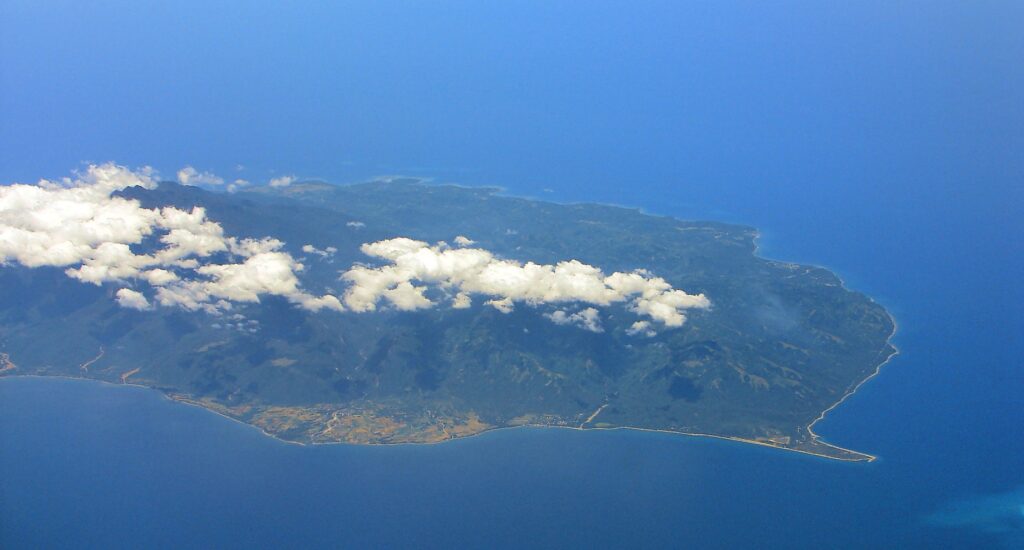
Photo: Wikimedia Commons
Geography and Biodiversity
Sibuyan Island is located in Romblon province, Philippines. It covers an area of 445 square kilometers and is often referred to as the “Galapagos of Asia” due to its unique blend of natural features. Towering above the island’s lush greenery is the infamous Mount Guiting-Guiting, a magnificent peak that reaches a height of 2,058 meters, attracting hikers and mountaineers from around the world. Sibuyan Island is home to dense virgin forests that are filled with endemic plants and animals, including the rare and endangered Philippine hanging parrot (Loriculus philippensis bournsi) and the endemic Sibuyan pitcher plant (Nepenthes sibuyanensis).
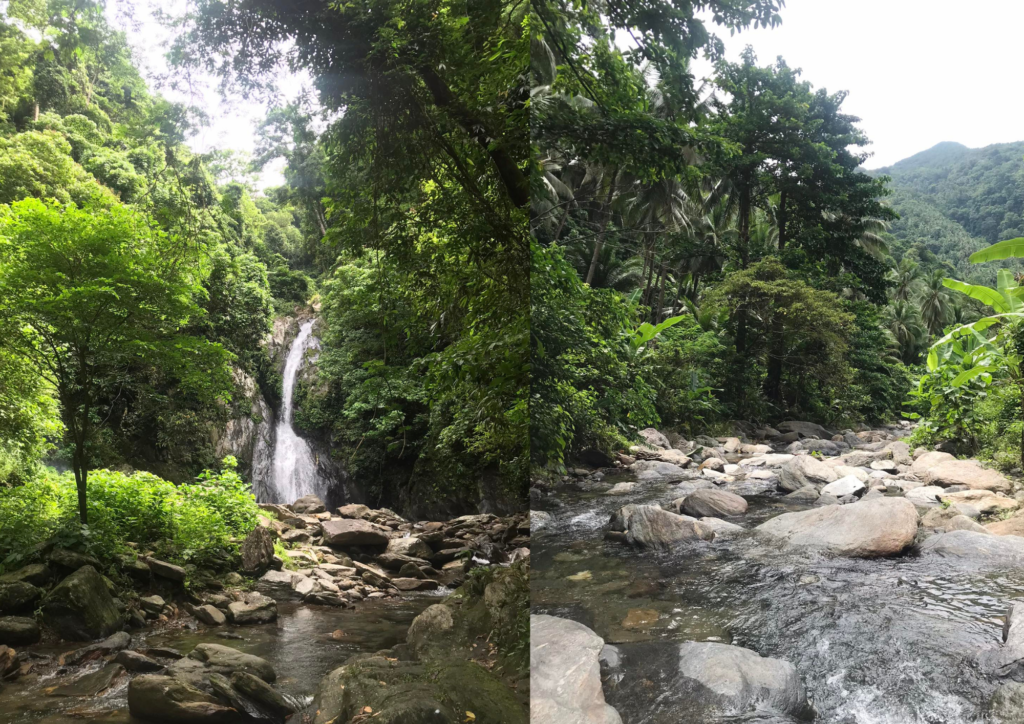
Photo: Johnny Flores
There are about 44 waterfalls on the island, connected by clear rivers and streams that flow through its beautiful valleys, including the well-known Cantingas River, considered one of the cleanest rivers in the world. These water bodies supply enough fresh water to the local communities and farm irrigations. Beneath the surface, Sibuyan Island’s marine ecosystem thrives with vibrant coral reefs and a wide range of marine life, making it a paradise for snorkelers and divers, and a food basket for local communities. The table below shows the summary of protected areas and biodiversity of Sibuyan Island.
| Protected Areas | Mt. Guiting-Guiting – (15,260.48 has)Mangrove Swamp Forest Reserve – Under Presidential Proclamation No. 2152Indigenous People’s Ancestral Domains – (8,408 has)Marine Protected Area – (348.96 has) |
| Flora | 700 vascular plant species – 54 of which are endemic to Sibuyan Island144 species of trees recorded – 10 of which are on the International Union for the Conservation of Nature (IUCN) “Red List” or considered endangered species. 33 of the tree species on the island are endemic to the Philippines. |
| Fauna | 83 wildlife species found on the island are endemic to the Philippines – 4 of which are endemic to Sibuyan.18 of the recorded wildlife species on the island are on the IUCN “Red List” or considered endangered species. 130 bird species recorded. |
Natural Resources and Minerals
Sibuyan Island is well-known for its mineral-rich soil, which holds significant deposits of valuable resources such as nickel, chromite, and copper. These minerals have attracted entrepreneurs and mining corporations due to the potential for profitable ventures. The island also possesses abundant non-metallic minerals, including limestone and silica, essential for various industrial applications.
Moreover, according to some locals, certain island regions are believed to hold gold, emerald, and marble deposits. These precious minerals further contribute to the island’s potential economic value.
Local Communities and Indigenous People
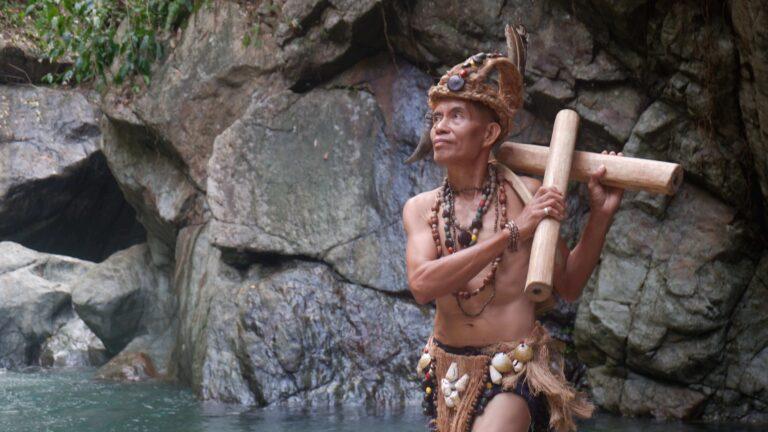
Photo: Angelo the Explorer
Sibuyan Island has only approximately 62,000 people residing in three municipalities, Cajidiocan, Magdiwang, and San Fernando. Among its inhabitants are the Sibuyan Mangyan Tagabukid (SMT) indigenous, whose rich cultural heritage is deeply connected with the island’s natural environment.
The community’s way of life on Sibuyan Island revolves around their harmonious relationship with nature. They deeply respect the land, forests, and rivers, which they consider sacred. Traditional farming practices, such as sustainable swidden or slash-and-burn agriculture, help the land regenerate over time. Additionally, crafting, such as basket weaving and wood carving, was a significant source of income for the community.
Fishing is another vital aspect of the community’s livelihood due to the island’s abundant marine resources. Fishing methods employed by the locals are often traditional and low-impact, ensuring the preservation of the marine ecosystem and the sustainability of their catch. Moreover, the SMTs preserve their cultural traditions, including music, dance, and craftsmanship. These valuable practices are passed down through generations, reminding them of their unique identity and deep connection to the island’s natural world.
Timeline of Mining on Sibuyan Island
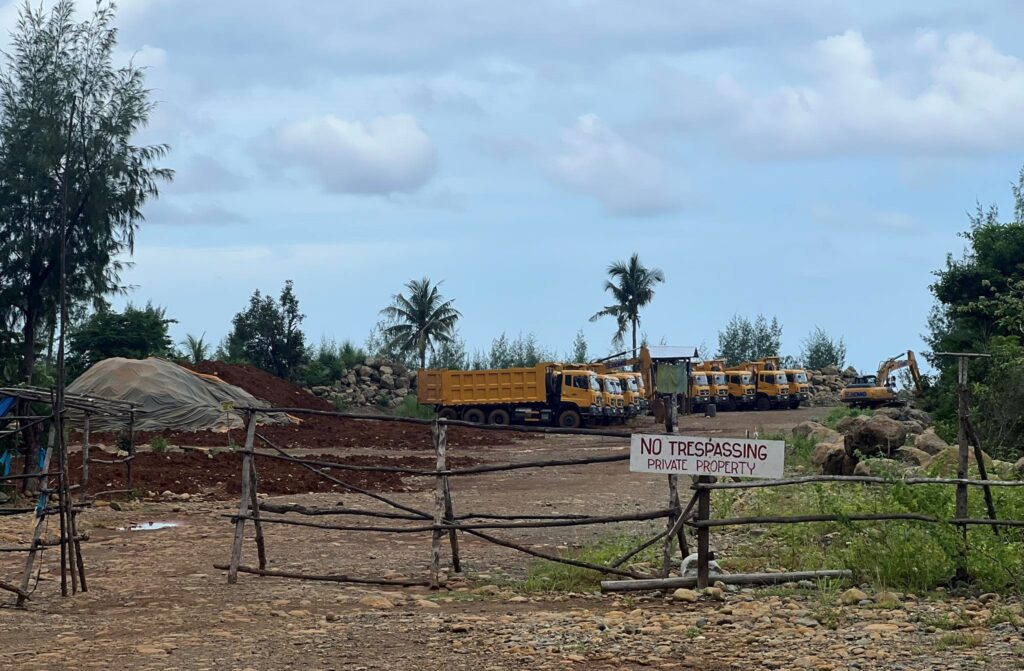
Photo: Johnny Flores
The Beginning of Mining in Sibuyan
According to Mr. Alfreo Pascual, one of the founders of the environmental and anti-mining organization Bantay Kalikasan ng Sibuyan (Nature Guardians of Sibuyan), the illegal mining activity in Sibuyan Island traces its roots back to the 1980s when mining companies first set their sights on its mineral-rich land. The discovery of valuable minerals, particularly gold, prompted initial interest in the island’s potential. However, the enthusiasm was short-lived as the quality of the gold found needed to meet the desired market standards, and the quantity fell below the required threshold of at least 500 metric tons per day for a minimum of 10 years of mining to be considered profitable.
Despite this setback, another mining company conducted a comprehensive exploration to assess the mineral deposits on the island. Their findings revealed that Sibuyan Island has a significant quantity of high-grade nickel, making it a new prime target for mining operations. This discovery catalyzed renewed interest in mining activities on the island.
By the year 2000, various mining companies began applying to the government for Mineral Production Sharing Agreement (MPSA). This agreement allows a private mining contractor to mine an area with no title on the contract area.
In 2009, the former environmental secretary of the Philippines, Lito Atienza, awarded the MPSA to ALTAI Philippines Mining Corporation (APMC). However, it is essential to note that at this stage, the company received only a permit for the exploration, extraction, and transportation of nickel ore samples for feasibility studies. Extracting and transporting large quantities of nickel ore for business transactions is subject to other application and evaluation processes, such as the Declaration of Mining Project Feasibility (DMPF) and Environmental Compliance Certificate (ECC). This declaration and certificate will prove that the mining project is both technically and financially viable, as well as socially and environmentally compliant.
The issuance of an exploration permit marked a critical juncture in the timeline of illegal mining on Sibuyan Island. As companies sought to capitalize on the island’s mineral wealth, the stage was set for further developments with significant implications for its environment and inhabitants. Today, there are multiple mining claims in Sibuyan from different mining companies covering almost half of the island, including some of its protected areas.
The Conflict Between the APMC and Local Communities
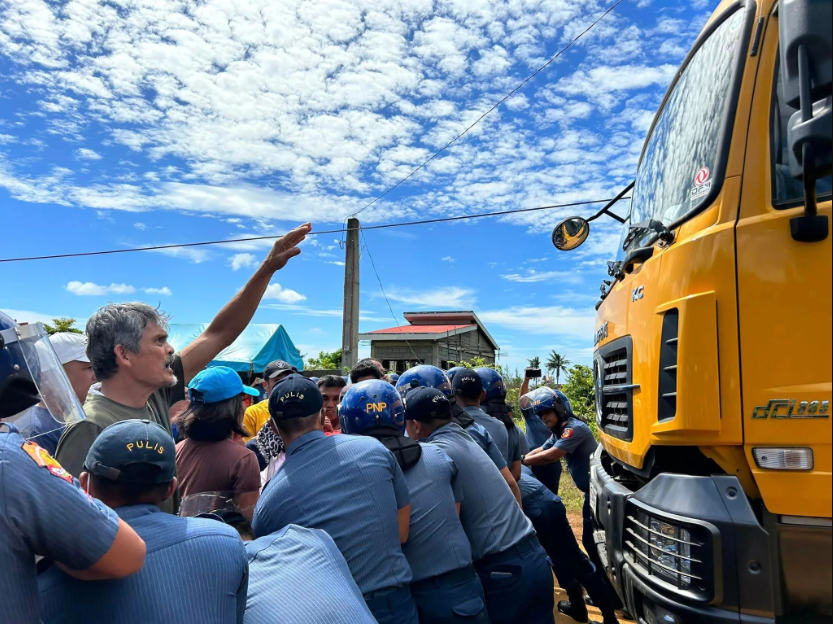
Photo: Alyansa Tigil Mina
In 2011, APMC’s MPSA was suspended by the Mines and Geosciences Bureau of the Philippines (MGB) through a cease and desist order. This is due to contamination complaints and alteration of inland water bodies. However, after ten years, the suspension was lifted in September 2021, allowing APMC to resume mining activities. According to local anti-mining leaders, APMC had already engaged in transactions with a nickel ore buyer from Hong Kong during this period despite needing more complete certifications and permits for conducting mining operations. During this time, the local government of Sibuyan Island has remained silent on these ongoing activities, providing APMC with an advantage to carry out alleged illegal mining operations.
The continuation of mining activities has caused concern among many residents opposed to mining on their island. Because of this, various anti-mining organizations have emerged, intending to stop further mining activities conducted by APMC. In February 2023, the anti-mining organizations organized a rally to protest against APMC, citing deforestation and the construction of a causeway that could potentially disrupt the natural habitat of marine species.Two days after the rally, a massive vessel docked on the coast of Sibuyan Island prepared to load and transport 50,000 metric tons of extracted nickel ore to Hong Kong with an estimated value of around 2 million USD. This sparked a physical confrontation between the residents and APMC. The residents constructed a human barricade to prevent the trucks carrying nickel ore from leaving the island. It is reported that during this incident, two residents were hurt.
As news of the incident spread through the national media, calls were made to investigate the situation, temporarily suspending mining activities. In an official report released by the Department of Environment and Natural Resources (DENR) on February 6, 2023, they issued a Joint Order to APMC regarding the illegal construction of the causeway and other related activities.
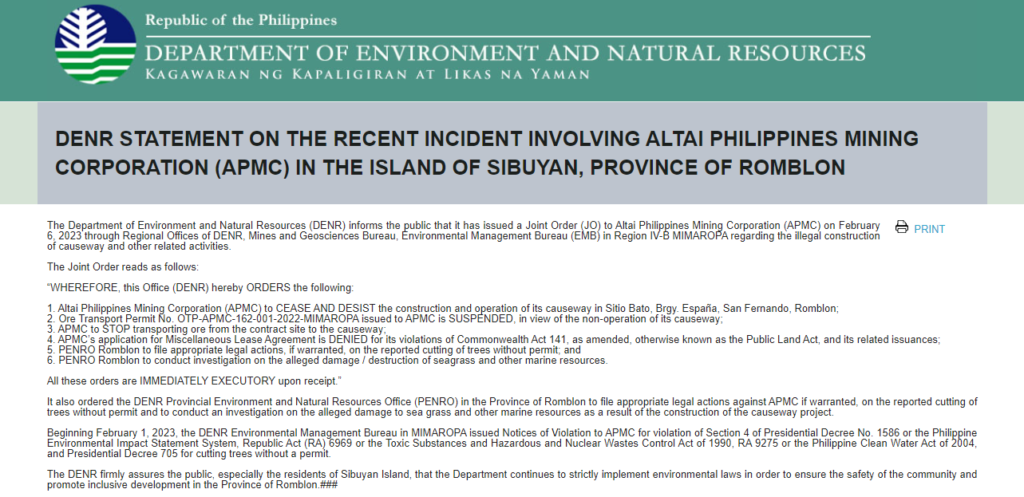
In a response statement released by APMC, the company said they had secured all the necessary permits and licenses to conduct mining operations on the island, denying all the allegations on their business legalities. APMC also claimed that the 50,000 metric tons of nickel ore will be transported overseas only for bulk testing.
Since then, residents and indigenous people, spearheaded by different anti-mining organizations, have consistently organized monthly rallies to raise awareness about the ongoing risk of exploitation from mining companies on their island. Aside from protests, the environmental organization Upholding Life and Nature (ULAN) has filed further legal actions against APMC to stop mining on Sibuyan Island.
Overpowering the Minorities
In an attempt to reclaim mining authority, there have been reports of alleged activities from the mining company that overpower the anti-mining residents of Sibuyan through various means.
Promising Job Security and Community Development Initiatives
According to some locals, the continuation of mining activities holds the promise of increased job stability through the mining company’s commitment to hiring island residents for various roles. Additionally, the company has pledged to enhance the quality of life for Sibuyanons by constructing vital facilities that will generate additional employment and livelihood opportunities. These facilities include hospitals, bee farms, and fisheries, which are expected to foster economic growth and prosperity within the community.
While these initiatives may potentially have a positive impact on residents, it remains unclear for Sibuyanons whether they will be sufficient to outweigh the environmental damage caused by the mining activities.
Silencing the Oppositions
As anti-mining organizations strive to put an end to mining activities in Sibuyan through community outreach and rallies, there have been allegations of attempts to silence individuals involved in the movement, potentially violating their human rights if proven true.
According to a statement from the Commission on Human Rights, there are reports of public teachers in Sibuyan being restricted from participating in anti-mining activities, including attending rallies and expressing anti-mining views on social media. Additionally, there are accounts of students being forced to issue public apologies for voicing opposition to mining on the island.
Community Relations
Since the mining operations stopped, APMC has been organizing various community relations programs in different towns of Sibuyan. These programs include basketball tournaments, relief operations, tree planting, Zumba activities, and educational meetings.
While the company may claim good intentions behind these programs, many Sibuyanons perceive them as attempts to persuade the residents. Some believe that these activities are intended to divert their attention from the anti-mining campaign.
The Environmental Impact of Mining on Sibuyan Island
Considering the island’s pristine condition and abundant biodiversity, the environmental impact of mining on Sibuyan Island is expected to be highly significant and detrimental. This section explores the past, present, and potential future state of the environment in Sibuyan if mining activities persist.
Environmental State of Sibuyan in the Early Years
In the early years, Sibuyan Island is recognized as one of the most pristine islands in the Philippines. Its forest area is considered one of the densest forests ever recorded globally, with an estimated 2,180 trees per hectare. The island’s lush forests and untouched mountains have provided a sanctuary for various wildlife species. Moreover, it is known for producing some of the purest freshwater in the world, sourced from its two healthy watersheds, Cantingas and Palangcalan. These watersheds play a crucial role in sustaining the livelihoods of most of the island’s population, residing in the San Fernando, Cajidiocan, and Magdiwang municipalities. The local communities heavily rely on these watersheds for their drinking water, farm irrigation, and eco-tourism.

Photo: Field Museum of Natural History
According to some locals, back in the 1960s, the water in Sibuyan was so clean that they could drink directly from the streams and rivers. Preserving this pristine water quality has been a goal for Sibuyanons for many decades. The increasing population and unregulated activities, such as small-scale mining, illegal logging, illegal charcoal making, and conversion of land for agriculture, have posed threats to the habitats of Sibuyan’s wildlife species and the water quality of both watersheds.
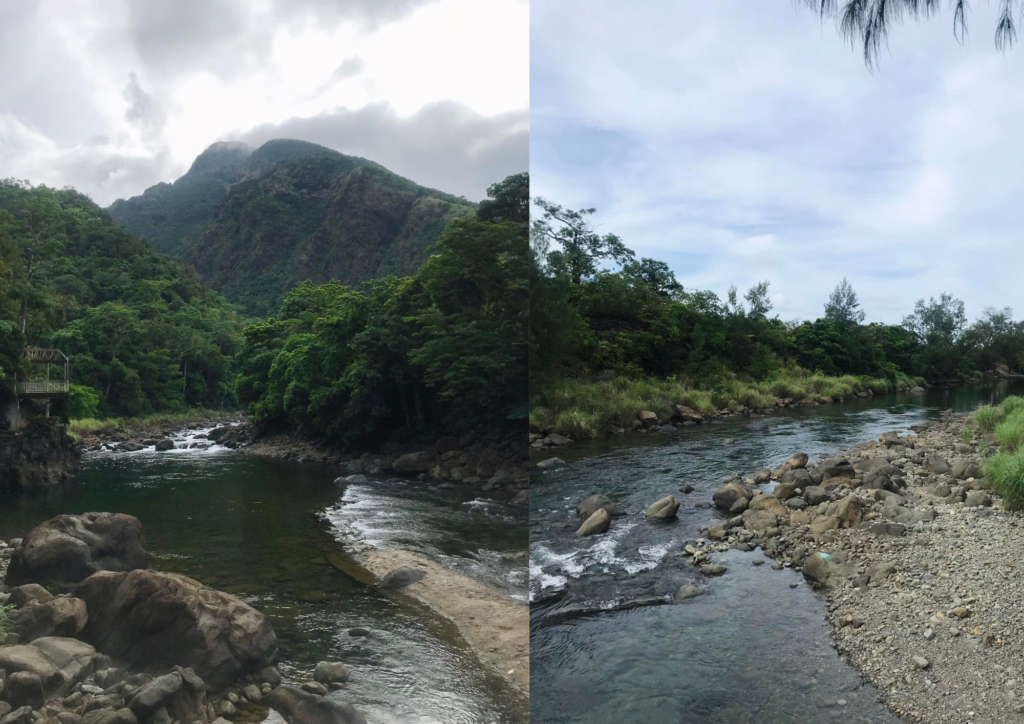
Photo: Johnny Flores
Fortunately, the declaration of Mount Guiting-Guiting as a protected area in 1996 was a significant milestone in the island’s conservation efforts. Over the years, this helped the island slow the potential environmental threats and preserve its pristine state.
Environmental State of Sibuyan After Mining Exploration
After APMC conducted its recent mining exploration activities, the once pristine environment of the island has suffered significant impacts.
1. To extract 50,000 metric tons of nickel ore, APMC cleared lush vegetation from the mining site, leading to the large-scale cutting of trees without the required permit. This illegal activity has raised serious concerns about its ecological consequences in the area, including:
- Loss of wildlife habitat
- Soil erosions and landslides
- Loss of indigenous flora and fauna
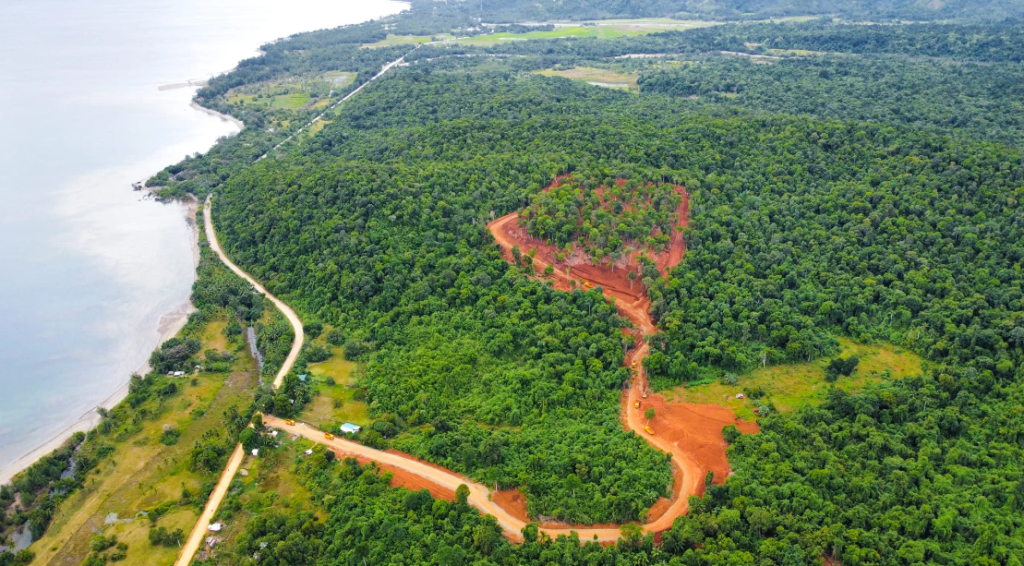
Photo: Rodney Galicha
2. To transport the extracted nickel ore to the mining vessel, APMC constructed a causeway on the shores of San Fernando without obtaining the necessary permits. Environmental activists fear the construction could damage marine life, particularly seagrass, and coral reefs in the coastal area where the causeway was built.
In response to these concerns and appeals, the Ecosystems Research and Development Bureau (ERDB), in collaboration with Coastal Resources and Ecotourism Research, Development and Extension Center (CRERDEC), investigated the alleged damage of seagrass and coral reefs in the area where the causeway was built.
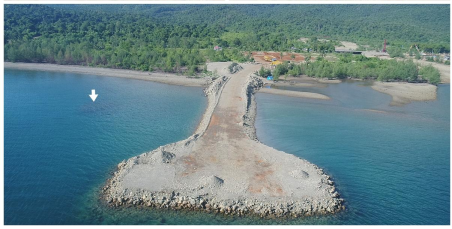
Photo: DENR-PENRO Romblon
According to the investigation, the causeway development did not directly affect or bury any coral reef due to its proximity to the river mouth, where corals do not thrive. However, the causeway construction can still significantly impact the coastal area. The analysis suggests that the causeway can alter the flow of water and sediments, affecting the speed and direction of water currents. It may also disrupt the natural patterns of longshore drift, which is the movement of sediments along the coastline, potentially causing changes in the shape and form of the beaches. These effects could lead to more significant issues, such as:
- Coastal erosion
- Instability of coastline
- Coastal flooding
- Surges
- Extreme tidal inundations.
Given these potential adverse environmental impacts, the investigation highlights the importance of thorough evaluation before building a causeway. Such an assessment should involve all stakeholders to ensure project implementation considers the ecological and natural resources protection, social benefits, and economic gains.
Although allowing mining is expected to create more job opportunities for Sibuyanons, there are valid concerns among residents and indigenous communities regarding the current damages and threats resulting from mining exploration activities, according to Engr. Jerome Gacu, a local youth environmental activist and member of the Alliance of Students Against Mining (ASAM), they are concerned that if the current impacts are already substantial, the potential consequences could be far worse if mining persists in the future. Nevertheless, they also worry that due to the pressing need for stable, long-term employment among residents, they might eventually accept mining in the future despite the risk.
Mrs. Veronica Batan, one of the prominent leaders of the environmental and anti-mining organization “Bantay Kalikasan ng Sibuyan” (Nature Guardians of Sibuyan), points out that any promised benefits of mining would be meaningless if the island’s environment and natural resources suffer damage and depletion, exposing the communities to potential health and calamity risks.
Future Environmental State of Sibuyan if Mining Continues
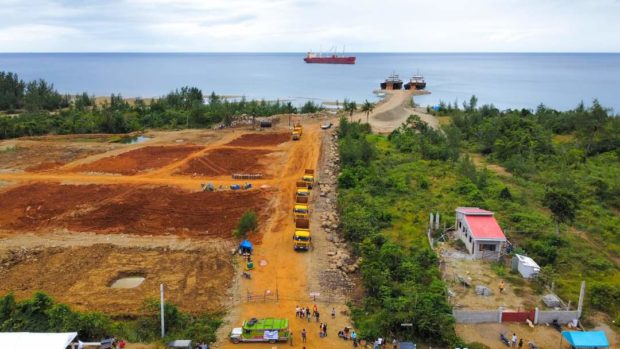
Photo: Gerardo Ribon
During our observations in the island communities, one significant issue that stood out was the need for education and awareness about the true environmental impact of mining and the potential health and calamity risks associated with it. Mr. Alfreo Pascual pointed out that misinformation is one of the biggest problems in Sibuyan. The spreading of rumors and opinions about the pros and cons of mining without a factual basis has led to confusion within the community.
To gain a better understanding, Mr. Alfreo Pascual and his colleagues consulted Dr. Edward Monjardin, a professor specializing in environmental and climate calamity risks. He explained that the effects of mining on an island like Sibuyan could go far beyond biodiversity loss and common calamities like soil erosion, landslides, and flash floods if the mining continues. According to Dr. Monjardin, the situation and the potential future environmental state of Sibuyan are comparable to his recent research on a neighboring island called Marinduque, which has faced severe environmental consequences due to mining.
The Marinduque Mining Disaster
The environmental disaster in Marinduque due to mining started from 1975 to 1991. During this period, the mining company operating on the island called Marcopper Mining Corporation disposed of approximately 200 million tons of mine tailings, a highly toxic mining waste, into Calancan Bay. This was done by constructing a tunnel that connected the mining site at Mt. Tapian to the Boac River, which then flows directly to the bay. This activity has caused an environmental disaster with immediate adverse effects, including:
- Contamination of Boac River with toxic mine tailings, resulting in the death of numerous fish species.
- Around 80 square kilometers at the bottom of Calancan Bay is covered by poisonous mine tailings, effectively burying all marine life forms beneath.
- Significant impact on the livelihood of fishermen in the area, as they heavily relied on Boac River and Calancan Bay for their catch.
After the natural resources at Mt. Tapian were depleted, Marcopper established another mining site nearby called San Antonio. The tunnel that connected Mt. Tapian to Boac River was sealed and repurposed as the mine tailing pit for the San Antonio site. However, to accommodate more mine tailings, Marcopper built a tailing dam in the Mogpog River in 1992. The construction of the tailing dam has caused further catastrophes for the community, including:
- Contamination of the Mogpog River with toxic mine tailings resulted in the death of numerous fish species.
- Accumulation of silt in river beds, generating floods in nearby communities.
- Flood waters carrying mud and toxic river water reach the town, causing damage to houses and rice fields and leading to the loss of livestock.
In 1996, the Mt. Tapian pit containing 23 million metric tons of toxic mine tailings leaked, releasing up to 10 cubic meters of toxic water per second. This toxic water overflowed to different villages situated near the Boac River. The effect of this incident is one of the most disastrous events in the mining history of the Philippines.
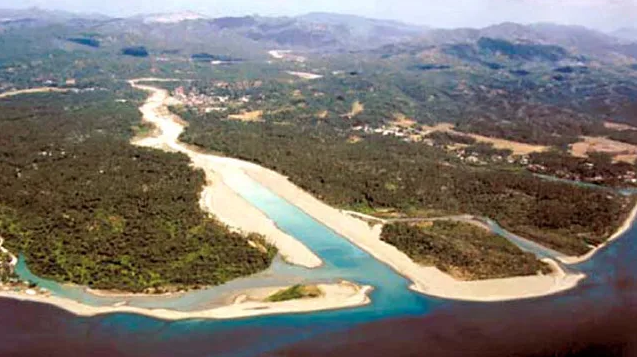
Photo: Newsbreak/Marcopper Mine Post Spill
- Flash floods buried nearby villages under 6 feet of toxic water.
- Toxic flood water destroyed agricultural fields and food sources on the island.
- The community’s primary source of drinking water became contaminated by toxic flood water.
- The government declared Boac River biologically dead due to the toxic levels that killed fish and other marine species.
- Months later, the Department of Health found nine residents with zinc levels in their blood exceeding safe limits by over 200%.
- River water samples showed toxic contamination levels 1,300% higher than the human tolerable level.
- Residents suffered from skin irritations and respiratory infections due to the toxic water and vapor.
Over the last three decades, the people of Marinduque have faced the consequences of mining activities. Until today, the Mt. Tapian pit remains filled with highly toxic water, which overflows into rivers and communities during heavy rainfall, causing ongoing suffering for the residents. There has been a noticeable increase in residents requiring amputations due to intoxication and infected wounds, and abnormalities in newborn babies in various communities on the island. Researchers have been closely monitoring and studying these health issues to understand their correlation with the toxicity levels on the island.
Potential Relevance of Marinduque Mining Disaster to Sibuyan Mining Situation
While mining in Sibuyan is currently far from causing the same environmental impact as in Marinduque, many environmentalists and anti-mining leaders believe it can reach a similar level of devastation.
The granted Mineral Production Sharing Agreement (MPSA) to ALTAI covers around 1,580 hectares of mining area on a mountain slope above and near watersheds, coastal areas, communities, irrigation systems, and rice fields. According to Mr. Alfreo Pascual, due to the mining area’s slope and geographical position, the mining activity may pose a significant risk of damaging and contaminating these areas below the mining site, particularly once they release mine tailings or heavy rainfall occurs.
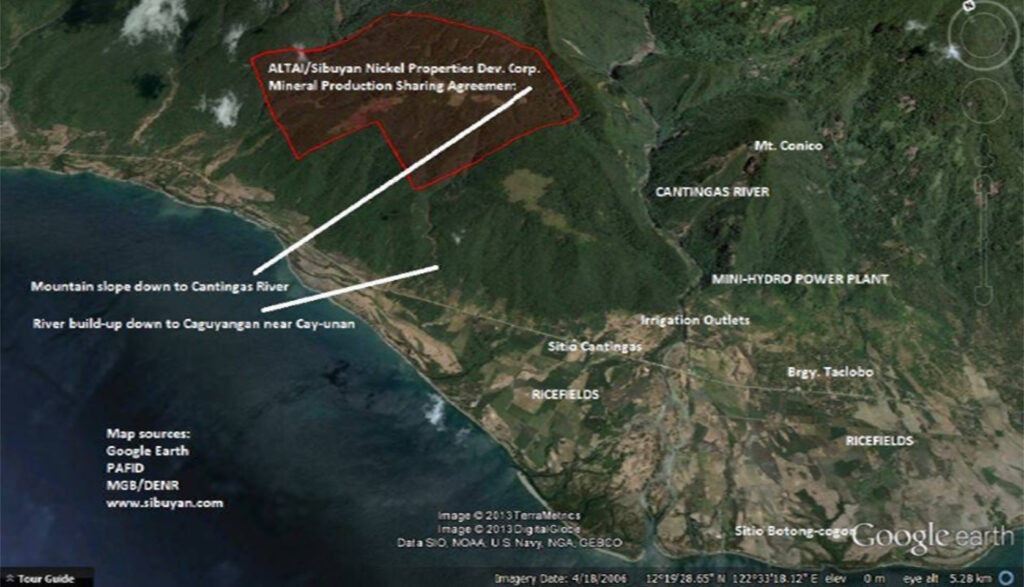
Photo: Romblon News Network
Community Efforts Against Mining in Sibuyan
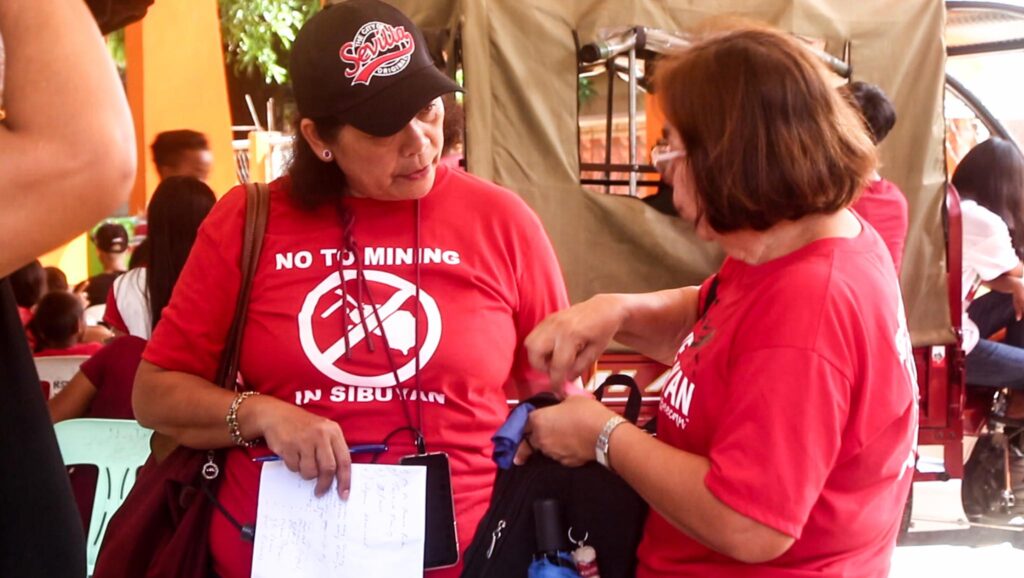
Photo: Louise Loresco
Early Efforts of Sibuyanons
Many Sibuyanons oppose mining on the island. Since the early 2000s, they have put forth tremendous efforts and sacrifices in their fight against mining. Numerous anti-mining organizations were formed, and rallies and legal actions were held. Some individuals even risked their lives to protect the environment.
In October 2007, Armin Marin, a former environmentalist from the World Wildlife Fund for Nature-Philippines and a town councilor in Sibuyan, was tragically shot dead after leading a rally against a mining operation attempted by Sibuyan Nickel Properties Development Corp. This incident served as a wake-up call for Sibuyanons, motivating them to take further action against those trying to exploit their island.
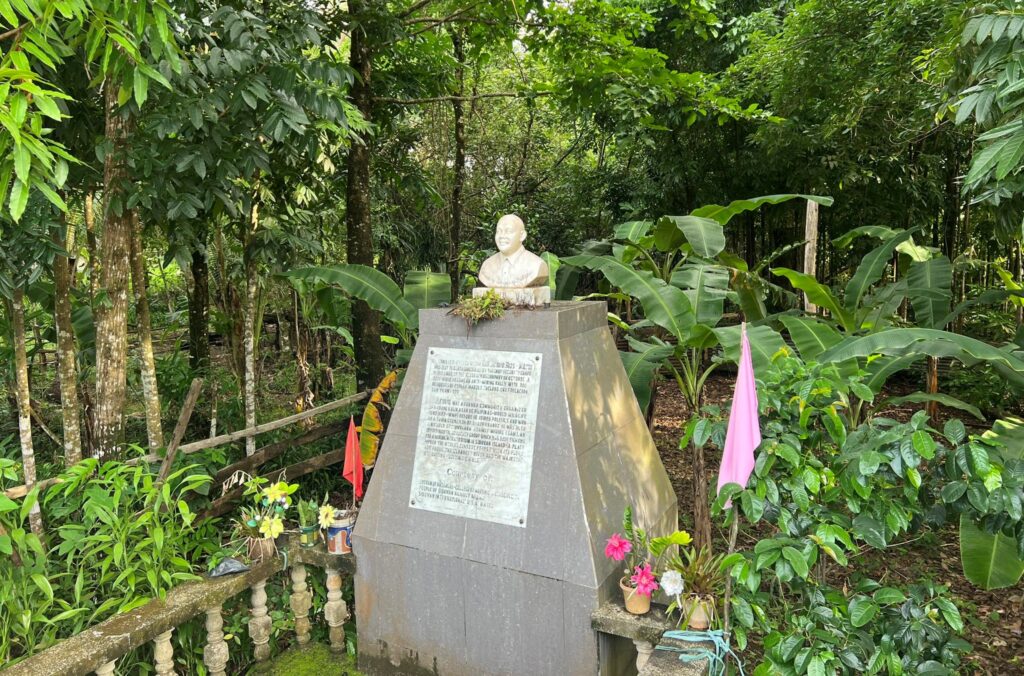
Photo: Johnny Flores
Since the nickel ore transportation attempt by APMC in February, the residents of Sibuyan have set up an outpost in front of the mining site, where the human barricade occurred. This outpost is constantly monitoring the mining site daily to prevent further illegal activities from happening again.
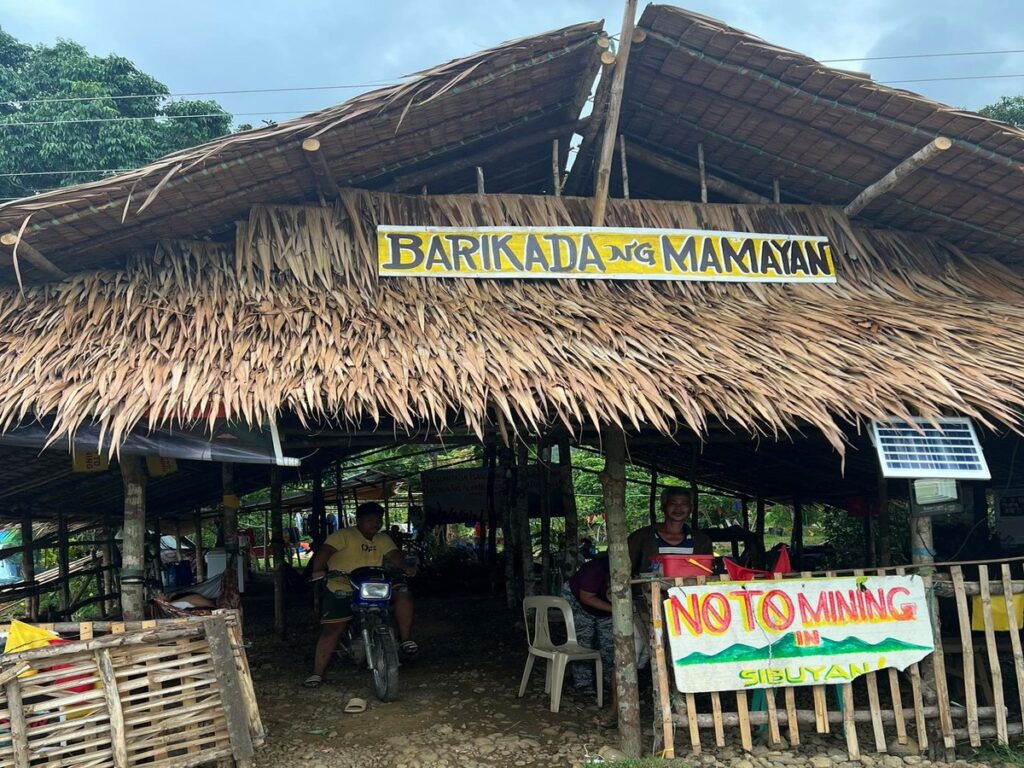
Photo: Johnny Flores
Small Victories of Sibuyanons
Today, community efforts against mining on the island are still ongoing. The success of the human barricade in February, which exposed illegal mining operations and led to the government stopping the mining activities, has been followed by more victories for the anti-mining residents of Sibuyan. More residents are now displaying “No to Mining” banners in front of their homes, and regular community outreach and rallies are taking place on the island. According to the anti-mining leaders, these actions are crucial to maintain the willingness of Sibuyanons to protect their island’s pristine environment and reputation.
A few weeks ago, anti-mining organizations in Sibuyan received another good news. The “Writ of Kalikasan” (Writ of Nature), which Sibuyanons requested, has been issued by the Supreme Court against the Department of Environment and Natural Resources, Mines and Geosciences Bureau, and APMC. The Writ of Kalikasan is a legal remedy for any individual or organization whose constitutional right to a balanced and healthy environment has been threatened or violated by an unlawful act of any public or private entity.
The issuance of the Writ of Kalikasan by the Supreme Court is an essential step for Sibuyanons on their way toward protecting Sibuyan Island against any form of environmental exploitation.
Educational Outreach: Raising Awareness
During our stay on the island, we witnessed another educational rally at the town hall of San Fernando municipality. The rally was organized by various environmental and anti-mining organizations, led by Bantay Kalikasan ng Sibuyan (Nature Guardians of Sibuyan).
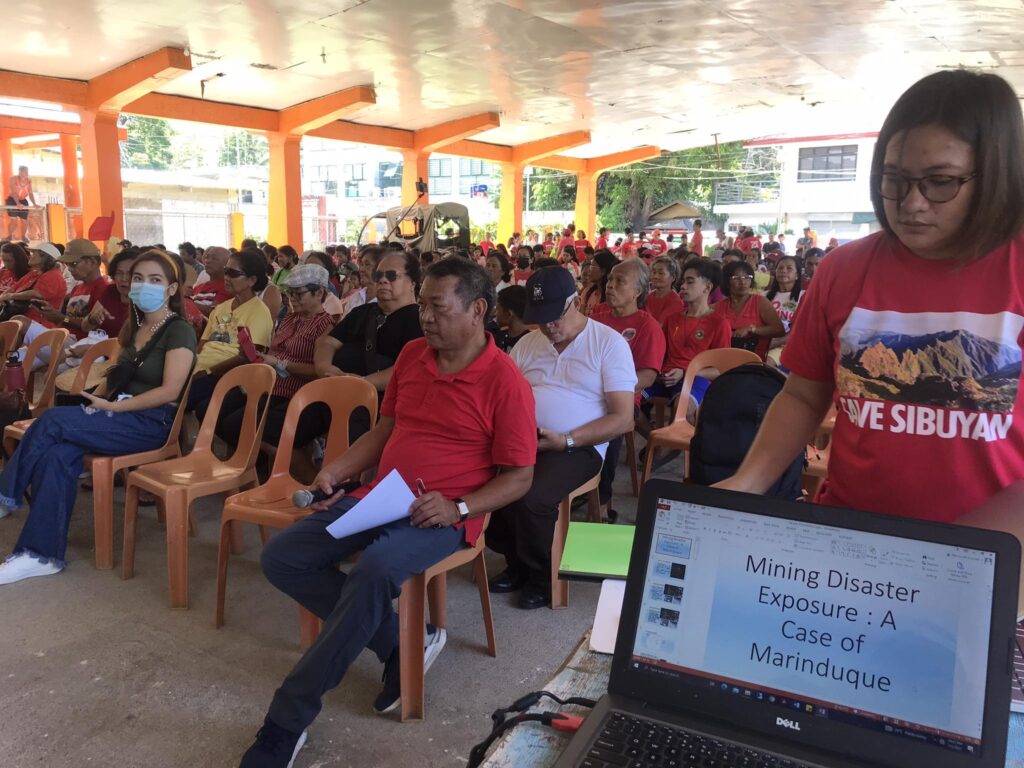
Photo: Johnny Flores
The purpose of the educational rally is to raise awareness among more Sibuyanons about the actual environmental impact and calamity risks caused by mining, aiming to address the issue of misinformation within the community. Dr. Edward Monjardin, one of the keynote guest speakers at the event, highlights the potential calamity and health risks of mining in Sibuyan by explaining the situation’s relevance to the Marinduque mining disaster.
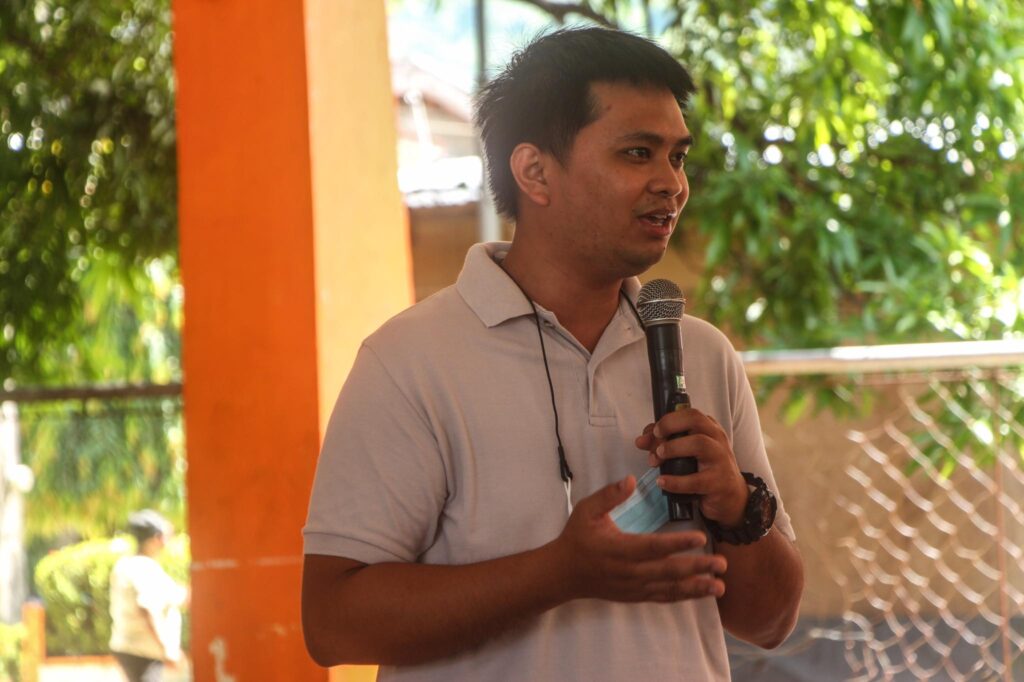
Photo: Louise Loresco
Dr. Monjardin also emphasizes the significance of maintaining a balance between development and the environment. Neither one should outweigh the other for communities to truly prosper. During his seminar, he informed the residents and indigenous people that excessive development could harm the environment and lead to calamities. At the same time, too much focus on environmental protection can hinder economic growth and progress for the community. However, he explained that there is a fine line between these two factors, and sustainable development is the key to benefiting the community.
Mrs. Veronica Batan from Bantay Kalikasan ng Sibuyan highlights the immense importance and beauty of Sibuyan’s environmental state and natural landscapes. These areas hold significant potential for eco-tourism rather than unsustainable development like mining. She also expressed her gratitude for the never-ending support and hard work of her colleagues, other environmental organizations, and the approximately 1,000 attendees of the educational event.
Mr. Alfreo Pascual led the question and answer portion for the attendees during the event. He reiterates the importance of continuing the fight for the environment, acknowledging that while they have achieved some small victories, the potential threat of mining in Sibuyan remains.
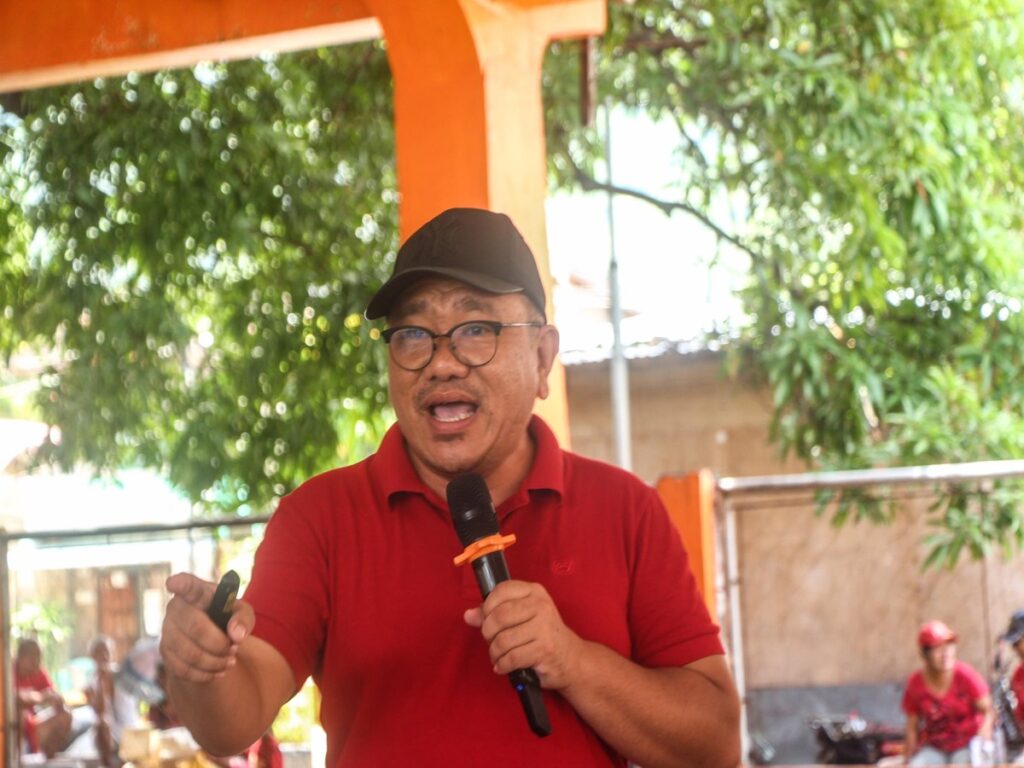
Photo: Louise Loresco
Additionally, environmentalist and human rights activist Mr. Rodney Galicha shares the latest news on the progress of their fight against mining on the island. He aims to keep the people informed about the current status of their movement, ensuring that the community stays updated on their efforts to protect their island’s natural heritage.
Furthermore, the event calls on the local government of Sibuyan to take a more proactive role in supporting the Sibuyanons’ efforts to protect the island’s environment.
Protecting The Future of Sibuyan Island: What We Can Do?
As the fight against mining continues, the fate of Sibuyan Island is still uncertain. The key to securing its future lies in striking a delicate balance between development and environmental protection. However, this task cannot be accomplished alone. It requires collaborative efforts and urgent actions from all stakeholders to ensure the protection of Sibuyan Island and the well-being of its people. Here are some strategies Sibuyanons can adopt to achieve this goal:
Promote Environmental Education and Awareness
Education and awareness are vital tools in tackling one of the significant challenges faced by Sibuyanons today against mining. By providing the community with information about the importance of the environment and the real impacts of mining, they can effectively counter misinformation, make informed decisions, and work together to create a shared vision for the island’s future.
Supporting environmental education programs and outreach initiatives can empower local residents to actively engage in preserving their island. Through knowledge and understanding, the community can take meaningful steps towards sustainable practices and protect the natural beauty of Sibuyan for generations to come.
Promote Sustainable Development Alternatives
While mining may offer economic gains, it is important to understand that such gains could be meaningless if the island’s environment and natural resources suffer irreversible damage. To secure a greener and safer future for Sibuyan, people must explore sustainable alternatives that can provide the same economic growth and progress. Here are two key alternatives to consider:
1. Promoting Eco-Tourism: Sibuyan Island is filled with amazing landscapes and underwater havens that tourists around the world are willing to see and experience. Leveraging these natural wonders can be a big opportunity for eco-tourism.
- Eco-tourism initiatives can be an ideal alternative that fosters both economic growth and environmental protection.
- Eco-tourism can create job opportunities and generate income for the local economy while also protecting the island’s ecological integrity, ensuring its natural beauty remains for future generations.
2. Expanding Market Opportunities for Sibuyan Seafood Products: Sibuyan Island is abundant with different marine species, making it a food basket and one of the main sources of income for the locals. Increasing market opportunities for seafood products can offer a promising chance to generate more jobs and boost the local economy.
- Improving and expanding marine protected areas on the island can significantly increase fish biomass and benefit both the marine ecosystem and local fishermen. More marine protected areas mean more fish and more fish means more catch for the fishermen.
- Opening direct access to national and international seafood markets can result in increased sales and an overall enhancement of the island’s economic status.
Advocate for Stronger Environmental Policies
To protect Sibuyan Island, the people need strong environmental policies in place. Both local and national governments must take responsibility for preserving their natural resources and the ecological balance of Sibuyan Island. Citizens can also make a difference by supporting stricter regulations on mining and advocating for policies that promote sustainable development and conservation.
Effective implementation of these policies requires collaborative efforts of all stakeholders, including government agencies, Non-Government Organizations (NGOs), local communities, and private businesses. Working together, they can develop a well-rounded strategy to tackle the island’s specific environmental challenges while ensuring its long-term sustainability.

